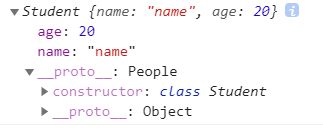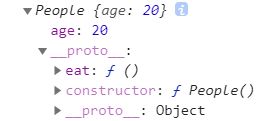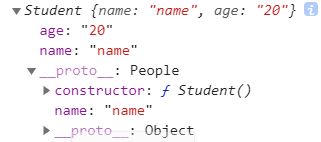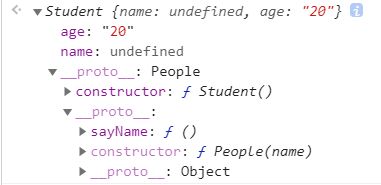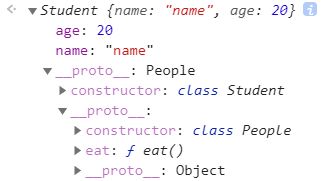一篇文章图文并茂地带你轻松学完 JavaScript 继承
JavaScript 继承
在阅读本文章之前,已经默认你了解了基础的 JavaScript 语法知识,基础的 ES6 语法知识 。
继承种类
简单的继承种类可以分为
- 构造函数继承
- 原型链继承
- class继承
- 寄生继承
其中 class 继承是 ES6 后提供的一种语法糖,方便其他面向对象语言的程序员更好的接受 JavaScript 中的继承,本质上还是原型链继承。
1. 构造函数继承
function Person() {
this.name = "name";
this.eat = function() {
console.log("eat");
}
}
function Student() {
Person.call(this); // 继承
this.age = 20;
}
const student = new Student();
console.log(student);
2. 原型链继承
原型与原型链前置相关内容可以参考 点这里
function Person() {
this.name = "name";
}
function Student() {
this.age = 20;
}
Student.prototype = new Person();
Student.prototype.constructor = Student; // 指利用 Student 构造函数 进行实例初始化
const stu = new Student();
console.log(stu.name); // "name"
console.log(stu);
利用在原型和原型链所学知识
Student 实例对象的 __proto__ 将会指向 Person 实例,从而实现继承的效果
stu:
3. class继承
constructor 是构造函数,可以结合原型链中的 constructor 属性看
class People {
constructor() {
this.name = "name";
}
}
class Student extends People {
constructor() {
super()
this.age = 20;
}
}
console.log(new Student())
可以发现,其实就是基于原型链继承,只不过 constructor 是 class Student
4. 寄生继承
在 JavaScript 设计模式中,有 工厂模式 ,具体可以上网查询
工厂模式 意味着只要传入适当的参数 (加工),就会给予一个实例,就像工厂制造东西一样。
而寄生继承,用的就是工厂模式的思想
function People() {
}
People.prototype.eat = function() {
console.log("eat");
}
function createInstance() {
const obj = Object.create(People.prototype)
Object.assign(obj, ...arguments);
return obj;
}
const stu1 = createInstance({
age: 20 });
console.log(stu1);
const stu2 = createInstance({
age: 30 });
console.log(stu2);
下面是 stu1 的打印结果
继承优化
1. 构造函数继承
利用 Student 构造出来的实例,属性和方法是不共享的
function People(name) {
this.name = name;
this.eat = function () {
console.log("eat");
};
}
function Student(name) {
People.call(this, name);
this.age = 20;
}
const stu1 = new Student("huro");
const stu2 = new Student("lero");
console.log(stu1.name === stu2.name); // false
console.log(stu1.eat === stu2.eat); // false
对于方法来说我们希望是共享的,否则实际上浪费了很多内存。
2. 组合继承
基于原型的方法是实例共享的,我们将方法放入原型,而属性放在构造函数内,这样就叫做组合继承,组合继承可以解决浪费多余内存的问题。
function People(name) {
this.name = name;
}
People.prototype.sayName = function() {
console.log(this.name);
}
function Student() {
People.call(this);
this.age = "20";
}
Student.prototype = new People();
Student.prototype.constructor = Student;
const stu1 = new Student();
const stu2 = new Student();
console.log(stu1.sayName === stu2.sayName);
然而,还是有个缺点,我们打印 stu1
在 __proto__ 中 有个 name 属性,这个属性其实我们是不需要的,我们希望每个实例能够独享属性,这个 name 属性的存在不但加大了内存开销,还导致当 delete stu1.name 的时候,出现还能使用 stu1.name 的情况,这是我们不想要的
3. 组合寄生继承
顾名思义,组合寄生继承就是结合组合继承和寄生继承
function People(name) {
this.name = name;
}
People.prototype.sayName = function() {
console.log(this.name);
}
function Student() {
People.call(this);
this.age = "20";
}
Student.prototype = Object.create(People.prototype); // 实际上只变化这一行
Student.prototype.constructor = Student;
const stu1 = new Student();
const stu2 = new Student();
console.log(stu1.sayName === stu2.sayName);
通过这种方式创造的继承,弥补了组合继承的不足,节省了内存,并且使得实例共享方法独享属性。
那么 ES6 语法提供的 class 是否也有这种 “聪明” 的设计呢?如果有的话,我们直接利用 class 就可以了
class继承
class People {
constructor() {
this.name = "name";
}
eat() {
console.log("eat");
}
}
class Student extends People {
constructor() {
super()
this.age = 20;
}
}
const stu1 = new Student();
const stu2 = new Student();
console.log(stu1.eat === stu2.eat); // true
extends 继承的是原型链的方法
super 继承的是独享的属性和方法
可以发现其实是和组合寄生继承类似的
哦哦,那肯定啊,不然 ES6 不被喷死啊。
继承优势 (选择)
用 ES6 的 class 语法有什么优势呢?
- 最大的优势是在于可以继承原生构造函数
原生构造函数
- Boolean
- Number
- String
- Array
- Date
- Function
- RegExp
- Error
- Object
在 ES5 语法中,你无法原生构造函数的属性,你可能会尝试这样写
const MyArray() {
Array.apply(this, arguments);
}
MyArray.prototype = Object.create(Array.prototype);
MyArray.prototype.constructor = MyArray;
当用这种方式继承的时候,你会发现他与 Array 这个类的行为完全不一致
const names = new MyArray();
names[0] = "huro";
console.log(names.length); // 0
原生构造函数无法绑定 this
而 class继承 可以
class MyArray extends Array {
}
const names = new MyArray();
names[0] = "huro";
console.log(names.length); // 1
- 是否一定具有
__proto__
在原型和原型链章节中,我们说到实例的 __proto__ 指向构造函数的 prototype
实际上并不是所有浏览器都是支持 __proto__ 的,而 class 作为构造函数的语法糖,一定有这两个属性。
- 更严格的控制
function People(name) {
this.name = name;
this.eat = function () {
console.log("eat");
};
}
function Student(name) {
People.call(this, name);
this.age = 20;
}
const stu1 = Student("huro"); // new?
console.log(stu1);
利用构造函数实例化对象的时候,如果忘传了 new 会怎么样,这个时候显然也成立,因为会被当做一个函数看待,由于是全局调用,因此 this 在浏览器环境下就是 window
这样相当于给 window 赋值了 name 和 eat
这个时候解释器也不会报错,因为没有任何方法可以区分一个函数是否是构造函数,因此可能出现意想不到的错误。
而用 class 方式继承,好处就是如果不写 new 直接报错。
class MyArray extends Array {
}
const names = MyArray(); // class constructor MyArray cannot be invoked without "new"
除此之外,在继承的构造函数里,如果没写 super 关键字或 super 不在构造函数顶部也会报错
class MyArray extends Array {
constructor(){
// Must call super constructor in derived class before accessing 'this' or returning from derived constructor
}
}
总结
更严格的语法检查,更多的优化,使得 class继承 应该是目前来看最为优质的继承方式。 为了能看懂他人的代码,以及更好的兼容性,其他的继承方式也要有所了解。


